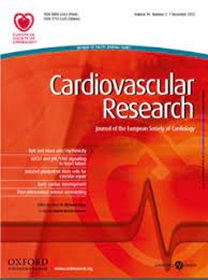Zinc-alpha2-glycoprotein modulates blood pressure by regulating renal lipid metabolism reprogramming - mediated urinary Na+ excretion in hypertension.
IF 10.2
1区 医学
Q1 CARDIAC & CARDIOVASCULAR SYSTEMS
引用次数: 0
Abstract
AIMS Organs modulating blood pressure are associated with a common cytokine known as adipokines. We chose Zinc-alpha2-glycoprotein (ZAG) due to its prioritized transcriptional level in the database. Previous studies showed that ZAG is involved in metabolic disorders. The aim of this study was to investigate its role in hypertension. METHODS AND RESULTS Serum ZAG levels were assessed in hypertensive and healthy participants. Blood pressure was monitored in Azgp1-/- mice and other animal models by 24-hour ambulatory implanted telemetric transmitters and tail-cuff method. Multi-omics analysis of proteomics and metabolomics were performed to explore possible mechanisms. Serum ZAG levels were significantly decreased and associated with morning urine Na+ excretion in hypertensive participants in a cross-sectional study. This study firstly reported that Azgp1-/- mice exhibited increased blood pressure and impaired urinary Na+ excretion, which were restored by AAV9-mediated renal tubule Azgp1 rescue. Azgp1 knockout caused the reprogramming of renal lipid metabolism, and increased Na+/H+-exchanger (NHE) activity in the renal cortex. Administration with a NHE inhibitor EIPA reversed the impaired urinary Na+ excretion in Azgp1-/- mice. Moreover, the activity of carnitine palmitoyltransferase 1 (CPT1), a key enzyme of fatty acid β-oxidation, was decreased, and the levels of malonyl-CoA, an inhibitor of CPT1, were increased in renal cortex of Azgp1-/- mice. Renal Cpt1 rescue improved urinary Na+ excretion and blood pressure in Azgp1-/- mice, accompanied by decreased renal fatty acid levels and NHE activity. Finally, administration of recombinant ZAG protein improved blood pressure and urinary Na+ excretion in SHRs. CONCLUSIONS Deficiency of Azgp1 increased the malonyl CoA-mediated inhibition of CPT1 activity, leading to renal lipid metabolism reprogramming, resulting in accumulated fatty acids and increased NHE activity, subsequently decreasing urinary Na+ excretion and causing hypertension. These findings may provide a potential kidney-targeted therapy in the prevention and treatment of hypertension.锌-α2-糖蛋白通过调节高血压患者的肾脏脂质代谢重编程--介导的尿液 Na+ 排泄来调节血压。
目的调节血压的器官与一种称为脂肪因子的常见细胞因子有关。由于锌-α2-糖蛋白(ZAG)在数据库中的优先转录水平,我们选择了它。以前的研究表明,ZAG 与代谢紊乱有关。方法和结果评估了高血压患者和健康参与者的血清 ZAG 水平。在 Azgp1-/- 小鼠和其他动物模型中,通过 24 小时卧床植入遥测发射器和尾套法监测血压。为探索可能的机制,进行了蛋白质组学和代谢组学的多组学分析。在一项横断面研究中,高血压患者血清 ZAG 水平明显下降,且与晨尿 Na+ 排泄相关。该研究首次报道了Azgp1-/-小鼠表现出血压升高和尿液Na+排泄障碍,通过AAV9介导的肾小管Azgp1拯救可以恢复血压和尿液Na+排泄。Azgp1 基因敲除导致肾脏脂质代谢重新编程,并增加了肾皮质中 Na+/H+- exchanger(NHE)的活性。服用 NHE 抑制剂 EIPA 逆转了 Azgp1-/- 小鼠受损的尿 Na+ 排泄。此外,Azgp1-/-小鼠肾皮质中脂肪酸β氧化的关键酶肉碱棕榈酰基转移酶1(CPT1)的活性降低,CPT1的抑制剂丙二酰-CoA的水平升高。肾脏 Cpt1 挽救改善了 Azgp1-/- 小鼠的尿 Na+ 排泄和血压,同时降低了肾脏脂肪酸水平和 NHE 活性。结论缺乏 Azgp1 会增加丙二酰 CoA 介导的对 CPT1 活性的抑制,导致肾脏脂质代谢重编程,造成脂肪酸积累和 NHE 活性增加,进而减少尿液中 Na+ 的排泄并引起高血压。这些发现为预防和治疗高血压提供了一种潜在的肾脏靶向疗法。
本文章由计算机程序翻译,如有差异,请以英文原文为准。
求助全文
约1分钟内获得全文
求助全文
来源期刊

Cardiovascular Research
医学-心血管系统
CiteScore
21.50
自引率
3.70%
发文量
547
审稿时长
1 months
期刊介绍:
Cardiovascular Research
Journal Overview:
International journal of the European Society of Cardiology
Focuses on basic and translational research in cardiology and cardiovascular biology
Aims to enhance insight into cardiovascular disease mechanisms and innovation prospects
Submission Criteria:
Welcomes papers covering molecular, sub-cellular, cellular, organ, and organism levels
Accepts clinical proof-of-concept and translational studies
Manuscripts expected to provide significant contribution to cardiovascular biology and diseases
 求助内容:
求助内容: 应助结果提醒方式:
应助结果提醒方式:


